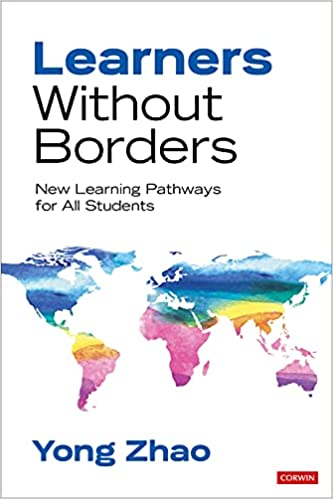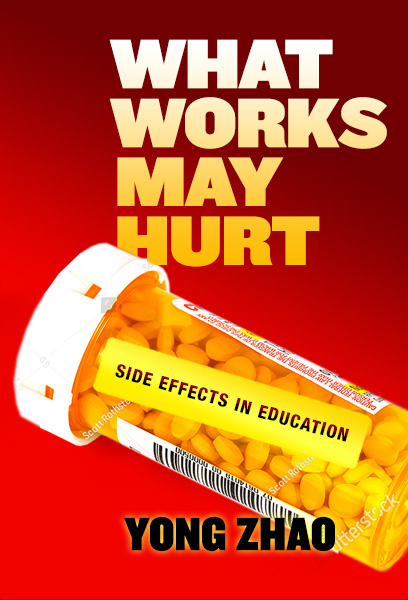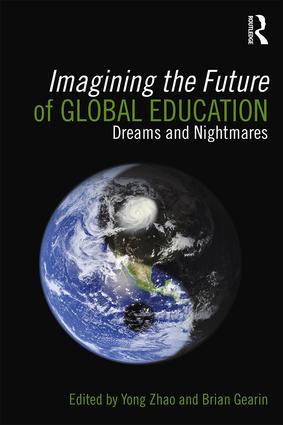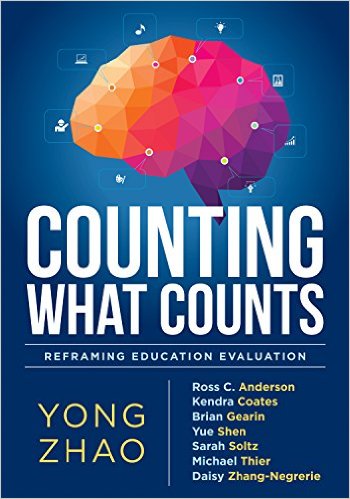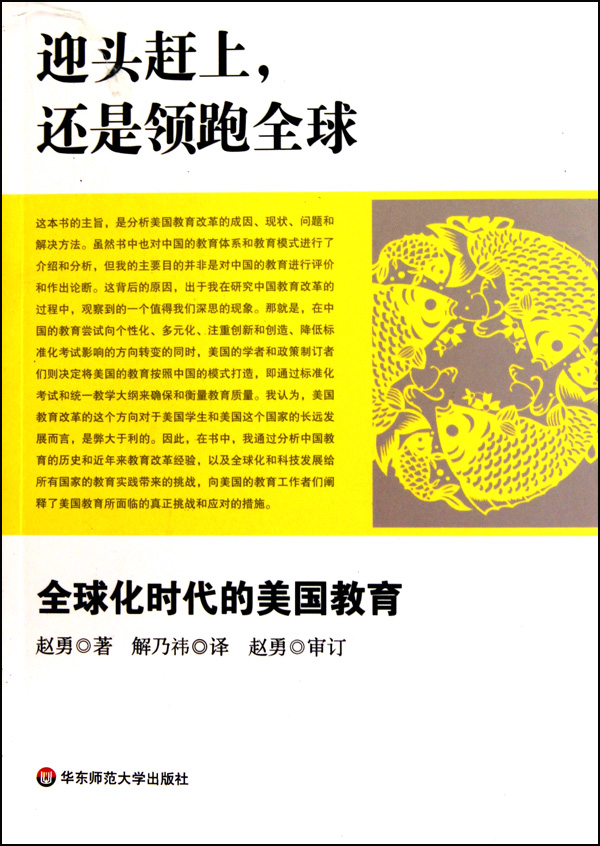How Not to Kill Creativity?
This is the draft of my chapter on creativity in the book Creative Provocations: Speculations on the Future of Creativity, Technology & Learning co-edited by Danah Henriksen and Punya Mishra that is recently published online. Read the published article here.
How Not to Kill Creativity?
Yong Zhao
University of Kansas
University of Melbourne
People in education have a very bad habit. Whenever something is said to be important, we try to teach it. Social and emotional learning (SEL) has gained importance so there are programs to teach it. Computational thinking is now considered important, so schools should teach. Growth mindset is important, bring it to the classroom. So are grit, resilience, and a host of other traits and abilities. If they are important, we must teach it.
When something has garnered enough importance in the minds of policy makers, it becomes something to teach. Before it can be taught in every school, a system has to accept it. Once accepted, it gets into the national or state curriculum framework or standards. Once it is in the standards, assessment comes along. Once assessment is made, schools begin to teach it and apply assessment to students. With assessment, schools can feel good about having incorporated the “it” into the curriculum and assessed this important thing.
But teaching may be exactly what is not needed. In fact, teaching may just be the opposite of what is needed. For example, SEL is ultimately concerned with student psychological and social wellbeing. But standardized schooling, testing, over teaching, and centralized homogenization destroy student well being, deprive them of the opportunities to play and interact with their peers, and place them under great pressure. The irrelevant lectures, meaningless homework, and nonsensical assessments gave student no time to exercise self-determination, to practice self-regulation, and to develop self-awareness (Wehmeyer & Zhao, 2020; Zhao, 2020a). As a result, while this kind of teaching may improve test scores, it hurts social and emotional development (Emler, Zhao, Deng, Yin, & Wang, 2019; Zhao, 2018b).
To improve SEL does not require teaching SEL. Adding SEL to state standards and require all students to have the same SEL skills can only make the situation worse because it places more pressure on teachers and students (Zhao, 2020a). What needs to be done is to examine the situation students are in and make decisions to remove the sources of pressure and anxiety and to increase time and space for self-determination and autonomous actions.
Creativity is one of the qualities that are emerging to be important in education. It has been listed as one of the four Cs (creativity, critical thinking, collaboration, and communication) necessary for the 21st Century (Partnership for 21st Century Skills, 2007). It is listed in different curriculum frameworks (e.g., (Australian Curriculum Assessment and Reporting Authority, 2010)). It is part of the Common Core curriculum in the United States (Common Core State Standards Initiative, 2011). Writings about creativity in the education literature have also been on the rise.
This is great news for creativity but at the same time it is worrisome. Creativity has not yet been made a required subject or course in schools, but for how long can we resist it? What if it is made a required subject? What if schools are forced to teach and assess creativity in the future? What happens if creativity is taught in schools as a required subject?
Dangers of Teaching Creativity
Teaching creativity as a school subject like math and science can be very dangerous. It can work to hurt the development of creativity in the population and in individual students. There are a number of ways this can happen.
First, when creativity is taught as a required course in schools, there must be a standard, a framework, or a sequence and scope. Otherwise, what is there to teach? Teachers must follow the standard, the framework, and the sequence and scope to plan lessons, to implement the lessons, and to make sure that students are indeed taught creativity. In a sense, standardization is required for classroom instruction of creativity following however creativity is thought and defined. Such standardization actually kills creativity effectively.
Creativity comes from the human desire to invent something new. It comes from the human nature to combine what is available and develop new possibilities. No matter how it is defined, creativity is individual. It is naturally born and can be suppressed or supported with experiences. Human beings, because of their interest, confidence, value, and abilities, can be more or less creative in different domains and contexts. They can also be more or less creative with different content and products. Some people may be more create in arts, others in music, still others in math. Some people may be more interested in creating new sculptures, others may be interested in writing poetry, and still others may want to explore new possibilities in science.
When they are taught to be creative, they are in essence forced to exercise their creativity for the purpose of getting a grade or going through a course. They are not necessarily exercising their creative potentials following their own desire and interest. Moreover, a course in school, if it is like most courses in schools, is about having students go through a standardized process led by the teacher. Thus a creativity course in schools would necessarily focus only on a narrow set of domains of interests. It is impossible for capture all possible areas that students can be interested in. Thus, for many students in the class, the only motivation they may have is to pass this course.
As a result, those students who are interested in pretending to have creativity following the course requirement may show some signs of furthering their creativity. But those who are not interested in so doing or are unable to do so will likely see their creativity decline. They would also be the ones who are considered less creative or lacking the ability to become more creative. Such decisions can be detrimental for students interested in and capable of being creative in the domains not included in the course. This is very much like students who are talented in non-school subject areas have been cast away as losers or at-risk (Zhao, 2018a). These students could lose interest in schools and also teach themselves as helpless.
Second, teaching creativity as a course in schools likely requires the teacher to teach certain strategies and actions that have been ostensibly proven to be effective in promoting creativity in the literature. While there are certainly strategies and tactics that have been identified as helping creativity growth in some areas, it is questionable if they apply to all areas. There is much debate about whether creativity is generic or domain specific. Without going into the details, I am pretty sure that there is no one set of strategies and actions that work for all students in all domains across all ages (Zhao, 2018b).
If there are no strategies and tactics that promote creativity for all students in all domains, whatever the course uses can misguide some students or waste their time because the course cannot possibly cover all areas. For example, a student interested in drama may have little to learn from strategies that promote creativity in science or engineering. Or a student who is excellent and interested in writing novels can be misguided by strategies that may be helpful for students interested in being creative math. Similarly, a student who is already quite creative in her own ways can be misled by the course content because she does not need it anymore. For a similar reason, a student who is way behind may not even understand what is being taught in the course.
Third, teaching creativity in a course can also hurt student development in creativity by taking time away from experiences that can actually help. Creativity is complex. One does not only need to be creative, to come up with novel ideas, he needs knowledge and skills to be meaningfully creative. Considering the 4 levels of creativity (Kaufman & Beghetto, 2009), we can say that everybody can have mini C but to become professionally creative, she needs professional knowledge and understand the professional landscape. Even little C requires knowledge and skills. Thus teaching creativity in isolation from knowledge and skills is mostly a waste of time. It may be an enjoyable exercise for some people but it can hardly make a person to be more creative.
Moreover, creativity is needed all the time. It is not a one-time deal. Thus a course taught at first grade to boost creativity may have lost its impact when the child enters third grade. So far we do not know how long the impact of creativity teaching lasts. We also do not know if creativity dissipates with time. Thus we need to ask the question is we need to teach creativity every semester or every year or every five years. Or perhaps, once you teach it, creativity lasts forever.
Dangers of Large-scale Assessments
Large-scale assessments, assessments that are applied to a large population as in the world, a nation, or state educational system, have been popular for the past few decades. Internationally we have the Programme for International Student Assessment (PISA) and Trends in International Mathematics and Science Study (TIMSS) besides others. Many countries and states have their own standardized large-scale assessments for accountability or selection of students. Typically these assessments can be high stakes, having significant consequence on students or educators. Even PISA and TIMSS, technically having no consequence on anyone, actually do have significant impact on policy makers in different countries.
Large-scale assessments can have many problems (Emler et al., 2019). One of the problems is that they can hurt the development of creativity. So far there is no large-scale assessment of creativity and almost all of them are assessment of abilities in different academic subjects such as math, reading, and science. These assessments actually squeeze creativity out of schools (Zhao & Gearin, 2016).
The large-scale assessments typically result in a process of standardization and centralization in schools. They start with frameworks of curriculum or assessment, which dictates what is to be assessed and taught in schools. The past few decades saw a significant increase in the centralization of curriculum standards and frameworks. Australia and the United States, for example, both countries that had historically made education a state responsibility, came up with national standards (Australian Curriculum Assessment and Reporting Authority, 2010; Council of Chief State School Officers & National Governors Association Center for Best Practices (NGA Center), 2010).
Centralization and standardization make a powerful process to exclude creative people instead of helping them to be more creative (Zhao & Gearin, 2016). Large-scale assessments, particularly when they are high stakes, require all students to do well. But human beings, as natural born and diverse learners due to interactions between nature and nurture (Lewontin, 2001; Ridley, 2003), cannot possible be the same. Thus as schools and teachers work very hard to make sure their students do well on tests, they limit opportunities for students to pursue their creativity, interests, and talents (Bonawitza et al., 2011; Nichols & Berliner, 2007; Zhao, 2018b).
Teaching to the tests has been a common practice in schools, which resulted in only subjects and content included in assessments to be included in the curriculum that students can experience. Over the past few decades, many schools have shifted attention to math and reading, reducing time for other subjects, even recess (Emler et al., 2019). Consequently students who are not interested reading and math or doing well on reading and math assessment can be deprived of the opportunity to develop their own talents and interests. They are deprived of the chance to trigger their natural born talents, to meet their needs, to excite their desires. Their creativity has no place to be cultivated and exercised (Tienken & Zhao, 2013).
Dangers of the PISA Creativity Assessment
Recently, PISA has decided to add creativity to its assessment package (OECD, 2019). The assessment was to be delivered in 2021 but due to the COVID-19 pandemic, the assessment is postponed to 2022. The assessment is intended to be taken by 15 years old students in different education systems in the world and has attractive goals:
The PISA 2021 creative thinking assessment will provide policymakers with valid, reliable and actionable measurement tools that will help them to make evidence-based decisions. The results will also encourage a wider societal debate on both the importance and methods of supporting this crucial competence through education. This work in PISA is connected to another OECD project that aims at supporting new pedagogies that can foster creative thinking. (OECD, 2019, p. 5).
There is no large-scale assessment that can validly and reliably assess what it claims to assess. Such is the case with the SAT and ACT, which could only predict college success at a fairly low level. And there is no creativity assessment that can predict well a person’s creativity in life. So what PISA has is an untested assessment for creative thinking. It plans to assess students in however many cultures and contexts as possible. The results will be numbers PISA extracts and the numbers will be used to judge which education system is good at cultivating creativity.
That decision is scary, scarier than the usual PISA results, which compare the quality of education of different systems based on test scores in math, reading, and science. The usual results have already created an illusion of educational excellence (Zhao, 2020b). While PISA claims that it measures what matters in the 21st Century, there is no evidence it does so, nor are there reasonable arguments that it does.
The potential decision that PISA will make based on the creativity assessment is likely to create another illusion of excellent in cultivating creativity. Because of the superpower of PISA and its owner the Organisation for Economic Co-operation and Development (OECD), it is likely that the PISA creativity assessment will be taken seriously in the world. It is quite possible that the creativity assessment becomes the de facto gold standard of creativity development in different education systems.
But the PISA assessment is not and cannot be the gold standard. It is just a test. Despite the theoretical arguments and research evidence documented in the framework (OECD, 2019), the assessment is a standardized fake test of creativity. It measures how well students perform on the test items instead of authentic creativity. At best, it can tell variations of student “creativity” on the items included in the assessment, which is drastically different from the real creative potentials, creative confidence, and creative interests a student may have.
While the assessment may or may not measure creativity, it can be believed to measure creativity among education policy makers, educators, parents, and students. If they believe it measures creativity, performance on the assessment becomes important for all involved. The result could be very simple teaching to the test, which happens a lot when a test becomes important. In other words, the content of the assessment can become the core of what is taught in schools. If the assessment truly measures creativity, it may not be a bad thing to teach it. However, the assessment cannot possibly measure creativity of students in all education systems around the world.
The PISA creativity assessment could also have a negative impact on creativity development in schools around the world because of its power. It could affect how people view creativity and creativity assessment. If parents, the public, and policy makers treat the assessment seriously, we could expect educational policies and practices that push PISA-defined creativity on students and in schools, which again would be a mistake because we do not know if it actually assesses creativity.
Opportunities and Dangers of Technology
Today, technology is an unavoidable topic when talking about creativity. First, digital technology is ubiquitous for students today. Today students spend more time on digital media than in schools (Rideout & Robb, 2019). Second, digital technology has become even more ubiquitous for students because of COVID-19. Every student in the United States, for example, should have access to the Internet and smart devices or computers. Third, digital technology has become an ordinary and common companion for students and teachers as a tool of learning and teaching. It is thus inevitable to think how technology may affect the development of creativity.
Technology is a double-edged sword for creativity. On the one hand, technology can drastically help the development of creativity in schools. For instance, with digital technology today, which would have cost millions 20 or 30 years ago, students can manipulate videos, audios, images, and texts easily on a smart phone or pad. They can also use resources created by others in creating their products. Moreover, there are instructional materials online that teach the skills and knowledge needed to create videos or music or other combinations of images, texts, and audios. Not only can students create meaningful products using their own materials and resources online, they can also publish them and make them available globally for anyone to use. This means that almost every student in developed countries has access to a great device that enables them to create, recreate, and publish their creative outcomes.
On the other hand, however, technology can hinder the development of creativity. First, technology can be used to manage and control students. With the power of technology today, it is easy to have all student data into a system. These data can be used to guide and plan students’ educational activities and pathways. For example, standardized test scores can be used to assign students into remedial programs or retain students for a grade. But standardized tests do not test students’ creativity or individual unique abilities. Assigning students to remediation programs in literacy and numeracy can be discouraging for students to develop creativity and unique talents. It also takes valuable time away from activities that can promote creativity.
Second, technology can be used to homogenize students. The current movement to use big data and learning analytics to develop personalized learning programs for students can actually homogenize students. Although the idea behind the computerized personalized learning programs seems to allow students to learn on their own, the outcomes are actual homogenization of learning because the content and standards are the same for all students. It forces students to learn the same thing at different speed.
Third, technology can mislead educational activities to promote the development of creativity. Because of the prominence and power of digital technology in schools, educators can easily mistake it as the only technology that can be used to support the development of creativity. As a result, students’ creative development can be limited to activities that are primarily based on digital technology. Students may be able develop creativity in videos, audios, and apps, but they may not be supported when they have interest or ability in other areas such as dancing, music, or physical environments.
What schools need to do is to consider the diversity of students and massive number of domains that need human creativity. Schools should not use technology excessively to control students’ creativity or use technology to homogenize them. Instead, schools should develop activities that support individual diversity and creativity in as many domains as possible.
What We Need to Do?
Creativity is certainly important and essential for human beings to thrive in the new world where technology is poised to displace human workers from many jobs (Zhao, 2012). There is no question that those who can create value, services, and products for others and the world will be more valued (Zhao, 2018a). Education must find ways to help all students to become more valuably creative. However what needs to be done is not to teach creativity courses or having creativity assessment.
What we need to do is to create an educational environment in which students can be productively creative. Less is more should be the philosophy of the new environment. What students need is not more teaching, more assessment. Instead they need time and space of their own, with proper and meaningful guidance from teachers and parents.
It is seductive to teach and assess creativity, but what is needed to cultivate creativity is space and time. Schools today are already overcrowded. A student’s time is fully with prescribed curriculum, pre-planned instruction, and predetermined organization. A student has very little time and space in school to deviate from the curriculum, the social and organizational norms, and the organized classes. So we do not need to add more courses. Rather, we should be taking things out of the student experience.
The first thing to take out is large-scale assessments. Schools have been pre-occupied with preparing students for these assessments. They are also very sensitive and pay a lot of attention to testing results. In some schools, much of students’ experience is occupied by these assessments. COVID-19 in many ways has made many governments to pause these assessments. It would be great if these assessments never return to schools.
Second, schools should cut back required courses. Almost all schools are subject to national or state curriculum, which prescribes all the school time to the teaching of required courses. Even private schools typically prescribe courses for time student has in schools. Students are asked to take the same courses based on their age. There may be elective courses, but typically they are offered by school teachers. To occupy all student time with required courses does not give students the time and space to develop their creativity in the areas they are interested in. Thus schools need to reduce required courses so as to enable students to take control of their own learning (Wehmeyer & Zhao, 2020; Zhao, 2012, 2018a). Students should be allowed to take courses and engage in other educational experiences on their own.
Third, retreat from over governance and over management. Students are over governed in schools and they are also over managed. Students are the agents of learning and thus should be the owners of their learning. But their agency is taken away so students are the least powerful people in schools. To perform the job of teaching, schools also manage their students carefully. Students are always with an adult teacher, who takes care of students’ attendance and monitor disciplinary issues. Students are not given the right to decide what they want to learn, when to learn, and where to learn. Students’ behaviors are also monitored all the time. In other words, they are expected to be students instead of themselves. To change the school into an educational environment that fosters creativity, schools need to become personalizable and give students the right to exercise self-determination (Wehmeyer & Zhao, 2020; Zhao, 2012, 2018a).
Of course, to create an educational environment that cultivates creativity does not end with simply taking things out and give students the space they need. It also requires a number of things that schools have not been doing. First, we need to create a culture that celebrates creativity and creative individuals. To celebrate creativity and creative individuals means to encourage everyone, student and staff, to be creative in their own way. It is not to predefine a narrow set of creative behaviors but to broaden the success of schools to include success in creativity. It is to enable individuals to pursue their interests and creative capacity. It is to have places and events to showcase the creative works of students and staff. It is also for staff to support and motivate students to become creative.
The second thing we need to add is to make sure that every student has a creative strengths profile (Zhao, 2018a). Education should be strength-based. Instead of focusing on fixing students’ deficit, it should be on developing individual differences (Zhao, 2016). In developing student’ strength, it is important that every student has a profile constructed with teachers and parents to record their strength, activities to strengthen the strength, and products to demonstrate the growth of the strengths. Strength-based education is about product-oriented learning, which means all learning should start by identifying problems worth solving and end with a solution (Zhao, 2012). This process requires the development and application of creativity. Thus a creative strength profile helps students to become aware of their strengths and creativity and accountable for their development.
The third thing we could add is to infuse creativity in all courses. Schools should focus on creativity as a core competence. It does not belong to one course but all courses. Students should have creativity-enhancing educational experiences all the time. All courses should be focusing on enhancing and developing student creativity, from kindergarten to 12th grade.
Finally, add online and global education to expand the opportunities for all students. Technology has become so mature that students do not need to take only courses from their school. In fact, COVID-19 has drastically changed education in schools. The short period of online or remote learning suggests that online and global learning is possible. Thus in order to meet the personal needs of each and every student, we must go beyond our own staff and courses. We need to engage students in a global learning ecosystem so that they are interacting with, learning with, and learning from anyone on the globe. They are also engaged in creative activities to create value for anyone on the globe.
Summary
Creativity is individual and diverse. Creativity is natural born but needs continuous nurturing and cultivation. For creativity to be expressed and developed, human beings need an open environment and strong encouragement. But students may have different domains where they want to be creative. Thus creativity cannot be taught as a required, standardized course for all students.
For creativity to become more than novel and random thoughts, for it to be valuable, human beings need to develop knowledge and skills. This makes creativity domain specific. But because human beings can choose which the areas they may be interested and good at, creativity needs to be fostered in ways that supports personalization of learning so that each and every student is able to enhance their creativity in their unique ways.
Creativity is life long quality of human beings. It needs a long process of continuous support and cultivation. Schools have not traditionally focused on developing creativity. In fact, schooling, as it has historically operated, hurts the development of creativity through standardization, centralization, and assessment. In the future, given the sophistication of learning technologies, schools need to change into a global learning ecosystem in which students have a strength-based, personalized creative learning experience.
References:
Australian Curriculum Assessment and Reporting Authority. (2010). A curriculum for all young Australians. Retrieved from http://www.acara.edu.au/verve/_resources/Information_Sheet_A_curriculum_for_all_young_Australians.pdf
Bonawitza, E., Shaftob, P., Gweonc, H., Goodmand, N. D., Spelkee, E., & Schulzc, L. (2011). The double-edged sword of pedagogy: Instruction limits spontaneous exploration and discovery. Cognition, 120(3), 322-330.
Common Core State Standards Initiative. (2011). Common Core State Standards Initiative. Retrieved from http://http://www.corestandards.org/
Council of Chief State School Officers, & National Governors Association Center for Best Practices (NGA Center). (2010, June 2, 2010). Introduction to the Common Core State Standards. Retrieved from http://www.corestandards.org/assets/ccssi-introduction.pdf
Emler, T. E., Zhao, Y., Deng, J., Yin, D., & Wang, Y. (2019). Side Effects of Large-Scale Assessments in Education. ECNU Review of Education, 2(3), 279-296.
Kaufman, J. C., & Beghetto, R. A. (2009). Beyond Big and Little: The Four C Model of Creativity. Review of General Psychology, 13(1), 1-12.
Lewontin, R. (2001). The Triple Helix: Gene, Organism, and Environment. Cambridge, MA: Harvard University Press.
Nichols, S. L., & Berliner, D. C. (2007). Collateral Damage: How High-Stakes Testing Corrupts America’s Schools. Cambridge, MA: Harvard Education Press.
OECD. (2019, April). PISA 2021 Creative Thinking Framework. OECD. Retrieved from https://www.oecd.org/pisa/publications/PISA-2021-creative-thinking-framework.pdf
Partnership for 21st Century Skills. (2007). Framework for 21st Century Learning. Retrieved from http://www.21stcenturyskills.org/documents/frameworkflyer_072307.pdf
Rideout, V., & Robb, M. B. (2019). The Common Sense census: Media use by tweens and teens, 2019. San Francisco, CA: Common Sense Media.
Ridley, M. (2003). Nature via nurture : genes, experience, and what makes us human (1st ed.). New York, N.Y.: HarperCollins.
Tienken, C. H., & Zhao, Y. (2013). How Common Standards and Standardized Testing Widen the Opportunity Gap. In P. L. Carter & K. G. Welner (Eds.), Closing the Opportunity Gap: What America Must Do to Give Every Child an Even Chance (pp. 113-122). New York: Oxford University Press.
Wehmeyer, M., & Zhao, Y. (2020). Teaching Students to Become Self-Determined Learners. Alexandria, VA: ASCD.
Zhao, Y. (2012). World Class Learners: Educating Creative and Entrepreneurial Students. Thousand Oaks, CA: Corwin.
Zhao, Y. (2016). From Deficiency to Strength: Shifting the Mindset about Education Inequality. Journal of Social Issues, 72(4), 716-735.
Zhao, Y. (2018a). Reach for Greatness: Personalizable Education for All Children. Thousand Oaks, CA: Corwin.
Zhao, Y. (2018b). What Works May Hurt: Side Effects in Education. New York: Teachers College Press.
Zhao, Y. (2020a). Another education war? The coming debates over social and emotional learning. Phi Delta Kappan, 101(8), 42-48.
Zhao, Y. (2020b). Two decades of havoc: A synthesis of criticism against PISA. Journal of Educational Change, 1-22. doi:10.1007/s10833-019-09367-x
Zhao, Y., & Gearin, B. (2016). Squeezed Out. In Creative intelligence in the 21st century (pp. 121-138): Springer.




